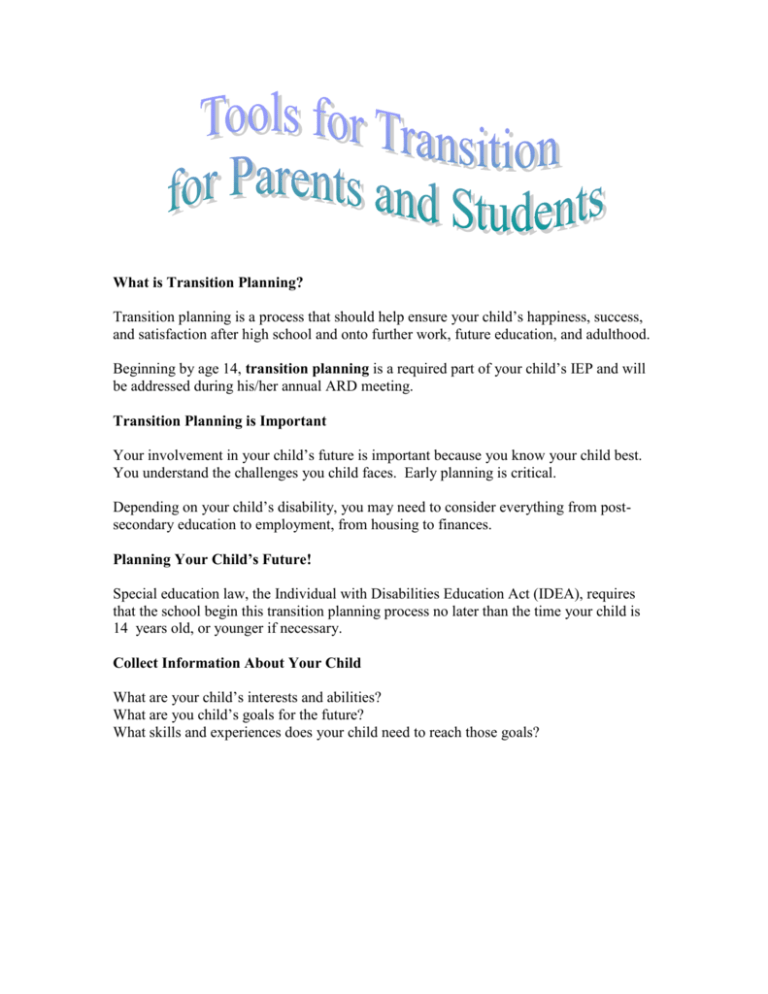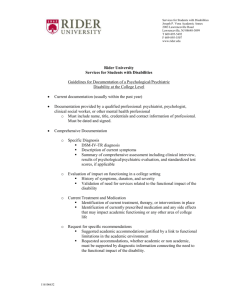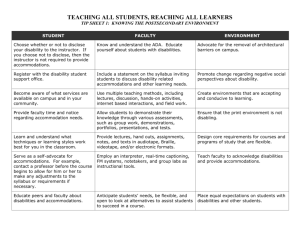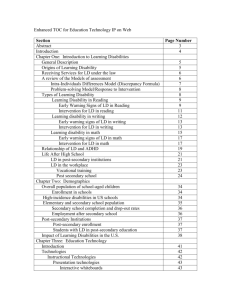Transition for Parents
advertisement

What is Transition Planning? Transition planning is a process that should help ensure your child’s happiness, success, and satisfaction after high school and onto further work, future education, and adulthood. Beginning by age 14, transition planning is a required part of your child’s IEP and will be addressed during his/her annual ARD meeting. Transition Planning is Important Your involvement in your child’s future is important because you know your child best. You understand the challenges you child faces. Early planning is critical. Depending on your child’s disability, you may need to consider everything from postsecondary education to employment, from housing to finances. Planning Your Child’s Future! Special education law, the Individual with Disabilities Education Act (IDEA), requires that the school begin this transition planning process no later than the time your child is 14 years old, or younger if necessary. Collect Information About Your Child What are your child’s interests and abilities? What are you child’s goals for the future? What skills and experiences does your child need to reach those goals? Tips That May Help Ease Your Child’s Transition To Adulthood 1. Help build your child’s self-determination and self-advocacy skills. All young people should have a strong sense of their strengths, abilities, and interests. If students have a disability, they should also be aware of how it might affect them at work, in the community, and in their educational pursuits. 2. Help develop you child’s social outlets. Social relationships and recreation are important tools that help tie people into the community and provide a wider network of support. 3. Expand your network and explore community supports. Develop helpful networks for your child. Who do you know in your family, social group, professional circle, religious community, or other area who could help provide social, recreational, work, or volunteer experiences for your young adult? Also look at adults in the community who have the same disability as your child to learn what kinds of support they use. 4. Make sure you son registers with Selective Service at age 18. All males— including those with disabilities—must register with Selective Service within 30 day of their 18th birthday. 5. Explore post-secondary accommodations. Students who receive academic programming and support in high school through Special Education will not automatically have the same support after they graduate. Although postsecondary institutions are required to provide reasonable accommodations to students with disabilities, they are not required to modify course work, if it would substantially change program requirements. When you and your student visit a prospective school, visit the campus’ Disability Services Office. 6. Investigate SSI programs. Financial planning is an important part of transition. 7. Encourage your child to build a resume by volunteering. 8. Help you child learn “soft” employment skills. These include such thing as being able to accept direction, ask for help, deal with conflict, and engage in interpersonal communication. They also include being prompt, having appropriate hygiene, and dressing appropriately for the workplace. 9. Plan for health care management. You should develop a clear plan on how to address health care needs once your child reaches adulthood. 10. Remember, at age 18, transfer of rights goes to your child. When your child reaches age 18 he or she becomes their own legal guardian. Many parents think that because their child has disabilities, they are automatically that child’s guardians no matter their age. This is not the case. If a person is not capable of taking care of personal safety, money management or health decisions, then parents must become the legal guardians in order to be able to make decisions.











